 Home
Home
 Back
Back

Bragg's Law is a fundamental principle in X-ray diffraction (XRD) analysis, which describes the angles at which X-rays are scattered by a crystalline material.
The law is named after William Lawrence Bragg and his father, Sir William Henry Bragg, who jointly formulated it in 1913. It relates the wavelength of the X-rays to the angle of incidence (θ) and the spacing (d) between crystalline planes in the material.
Mathematically, Bragg's Law is expressed as:
nλ = 2d sin(θ)
Where:
When X-rays strike a crystalline material at a specific angle θ, they are scattered by the atoms within the material. If the scattered waves interfere constructively (i.e., they reinforce each other), a peak in intensity is observed in the diffraction pattern. This occurs when the path difference between the waves scattered from adjacent planes is an integer multiple of the wavelength λ.
Bragg's Law is widely used in materials science, chemistry, and geology for determining the crystalline structure of materials, including their lattice parameters, crystal symmetry, and the presence of defects.